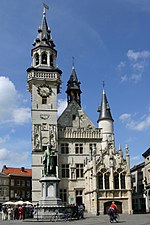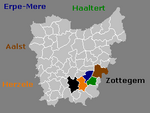Grote Markt (Aalst)

The Grote Markt (Dutch, pronounced [ˌɣroːtə ˈmɑr(ə)kt] (listen), Aalsters: Groeite Mert; meaning "Big Market") is the central square of Aalst, East Flanders, Belgium. The Aldermen's House, the Town Hall, the Beurs van Amsterdam, Herberg Graaf van Egmont and the Belfry/Schepenhuis are located there. The large square is broken by the protruding position of the Aldermen's House and the Herberg Graaf van Egmont, and is partly divided into several parts. The square behind the Aldermen's House (on Kattestraat) and the connecting street to Hopmarkt and Nieuwstraat are also referred to as part of the Grote Markt. The statue of printer Dirk Martens is also located on the square.The Grote Markt witnessed many tragic events unfold during its history. In 1524, the first female Protestant martyr Clara 't Roen was executed on the square. More than two centuries later, in 1748, the outlaw and gang leader Jan de Lichte suffered the same faith.
Excerpt from the Wikipedia article Grote Markt (Aalst) (License: CC BY-SA 3.0, Authors, Images).Grote Markt (Aalst)
Kattestraat,
Geographical coordinates (GPS) Address Nearby Places Show on map
Geographical coordinates (GPS)
| Latitude | Longitude |
|---|---|
| N 50.938333333333 ° | E 4.0388888888889 ° |
Address
De graaf van Egmont
Kattestraat
9300 (Aalst)
East Flanders, Belgium
Open on Google Maps










